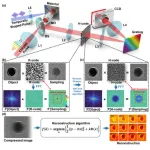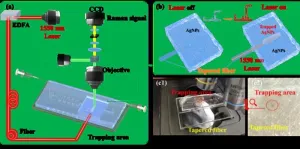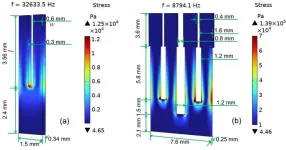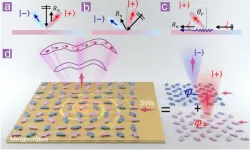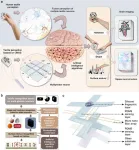(Press-News.org) Hoboken, N.J., February 7, 2025 — As winter storms and summer heat waves increasingly stress the nation’s power grids, Stevens researchers have developed a new way to identify the homes most vulnerable to blackouts — without even visiting them.
The timing couldn't be more critical. With more than a quarter of U.S. homes already fully electric, and solar installations set to triple during the next five years, understanding vulnerabilities has become critical for emergency planning and public safety.
"We're racing toward electrification to combat climate change, but we must also understand the risks involved," says Stevens professor Philip Odonkor, who led the research project. “So, what happens to these solar and electric homes when the power goes out?"
Summer strength, winter blues
Odonkor, with recent graduates and AI summer fellows Andrew Majowicz M.Eng. ‘24 and Chetan Popli M.S. ‘24, set out to answer that question.
In a new study published in the Journal of Smart Cities and Society, they explore the future of electrified American homes by leveraging AI and analyzing Department of Energy (DOE) building-stock data.
The team dug deep into the energy patterns of 129,000 single-family homes across eight states. Their goal? Uncover the hidden energy “signatures” that distinguish fully electrified homes — those powered entirely by electricity — from those that use a mix of energy sources.
They didn’t stop there, however. For identified mixed-energy homes, the team also worked to pinpoint exactly which appliances have made the shifts to electric power and which haven’t.
After processing and analyzing the dataset, Odonkor’s team found that homes’ energy signatures were not only distinguishable, but they also granted critical insights into the resilience of individual homes.
Solar-powered homes, for example, demonstrated impressive resilience during summer heat waves. However, they proved remarkably vulnerable during winter storms; in fact, fully electrified homes were nearly three times more vulnerable to winter outages, compared to those drawing power from mixed energy sources.
"Think about Texas in 2021, when millions lost power during a winter storm," Odonkor explains. "As more homes go fully electric, we need to prepare for these scenarios.” “Solar panels help in summer, but they can't meet the intense heating demands that occur during winter blackouts."
New methods to inform planning and response
The study wasn’t only pathbreaking for its findings; it was only notable for the innovative AI-powered methods that were used to conduct the analyses.
Odonkor’s team developed novel machine-learning models capable of identifying an individual home’s energy systems and vulnerabilities with over 95% accuracy, using only its energy-consumption patterns. The new approach enables utilities and emergency responders to pinpoint at-risk households across entire neighborhoods, without the need for invasive surveys or inspections.
“Until now, we actually had to go door-to-door to determine if a home was fully electric," notes Odonkor. "Now, we can automatically identify the most vulnerable homes while still safeguarding people’s privacy.” “This will shift the way we prepare for and respond to extreme weather, enabling faster, and more targeted action when it’s needed most."
The study’s potential benefits extend beyond empowering individual homeowners. As cities work to build climate resilience, these new tools could help community emergency-service units prioritize responses during outages. It could also assist urban planners in the long-term development of more resilient housing stock and neighborhoods.
That’s key, because communities nationwide are grappling with a one-two punch of aging power grids subjected to more frequent episodes of severe weather.
As we increasingly transition to electric homes to cope with climate change, the team’s findings serve as a warning that we will need implement strategies that protect vulnerable solar and electric households during winter emergencies.
“The path to sustainable cities isn’t just about going green; it’s about staying resilient,” he emphasizes. “As we shape the future of urban housing, understanding vulnerabilities isn’t just a luxury — it’s essential to keeping communities safe.”
END
Solar and electric-powered homes feel the effects of blackouts differently, according to new research from Stevens
Stevens professor Philip Odonkor, an expert in energy technologies, uses AI tools to investigate the impact of extreme weather on solar-powered and electrified homes and uncover their unique vulnerabilities and develop insights on how they handle harsh co
2025-02-08
ELSE PRESS RELEASES FROM THIS DATE:
Metal ion implantation and laser direct writing dance together: constructing never-fading physical colors on lithium niobate crystals
2025-02-07
A new publication from Opto-Electronic Advances; DOI 10.29026/oea.2025.240193 , discusses a novel approach towards robust construction of physical colors on lithium niobate crystal.
Color has a profound impact on the way humans observe, perceive and understand the world. It is like a silent language, subtly shaping our perception and response to the surrounding environment. From the first ray of sunshine in the morning to the twinkling stars in the night sky, colors are everywhere. They are not only a visual ...
High-frequency enhanced ultrafast compressed photography technology (H-CAP) allows microscopic ultrafast movie to appear at a glance
2025-02-07
A new publication from Opto-Electronic Advances; DOI 10.29026/oea.2025.240180 , discusses high-frequency enhanced ultrafast compressed photography technology.
Single-shot ultrafast imaging technology can characterize transient events under a wide range of conditions. It opens the door to explore the unrepeatable or difficult to reproduce ultrafast phenomena such as photosynthesis at the molecular or atomic scale in nature and the precision manufacturing of semiconductor ...
Single-beam optical trap-based surface-enhanced raman scattering optofluidic molecular fingerprint spectroscopy detection system
2025-02-07
A new publication from Opto-Electronic Advances; DOI 10.29026/oea.2025.240182 , discusses a single-beam optical trap-based surface-enhanced Raman scattering optofluidic molecular fingerprint spectroscopy detection system.
Raman spectroscopy is a non-destructive analytical technique that allows for precise analysis of substances based on their unique molecular Raman spectral characteristics. However, traditional Raman spectroscopy techniques suffer from weak signal intensity, limiting their sensitivity in high-sensitivity detection applications. Surface-enhanced Raman scattering (SERS) technology, on the other hand, can amplify Raman signals by several million ...
Removing large brain artery clot, chased with clot-buster shot may improve stroke outcomes
2025-02-07
Research Highlights:
Stroke survivors were more likely to have little or no disability after 90 days if a clot was removed from a large brain artery followed by the injection of the clot-dissolving medication tenecteplase directly into the artery near the blockage, compared to people receiving standard medical treatment after clot removal. In this trial, standard care was clot removal without clot-dissolving medication.
The added treatment may work by dissolving blood clots in the small vessels (microcirculation) near the major blockage, reducing the amount of brain tissue deprived of blood.
The ANGEL-TNK trial found that this approach was ...
A highly sensitive laser gas sensor based on a four-prong quartz tuning fork
2025-02-07
A new publication from Opto-Electronic Advances; DOI 10.29026/oea.2025.240275, discusses A highly sensitive laser gas sensor based on a four-prong quartz tuning fork.
Trace gases, though have a volume fraction much less than 1% of the atmosphere, significantly impact various sectors. Despite their low concentration, typically between 10-12 to 10-6, gases like nitrogen oxides (NOx), sulfur dioxide (SO2), and greenhouse gases contribute to atmospheric pollution, a pressing global issue exacerbated by industrialization and urbanization. Moreover, detecting trace gases is crucial for industrial ...
Generation of Terahertz complex vector light fields on a metasurface driven by surface waves
2025-02-07
A new publication from Opto-Electronic Sciences; DOI 10.29026/oes.2025.240024, discusses generation of terahertz complex vector light fields on a metasurface driven by surface waves.
With the rapid development of information and communication technologies, especially in the context of 5G, 6G networks, artificial intelligence, and the Internet of Things, the development of on-chip optical control devices with high bandwidth, high speed, low power consumption, and miniaturization ...
Clot-busting meds may be effective up to 24 hours after initial stroke symptoms
2025-02-07
Research Highlights:
In a randomized clinical trial in China, giving the clot-busting medication alteplase up to 24 hours after stroke symptoms first appeared increased the odds of better recovery by 50% compared to those who received standard antiplatelet treatment.
The results might extend the time window for patient treatment worldwide, particularly in regions that lack access to advanced medical procedures.
Note: The study featured in this news release is a research abstract. Abstracts presented at the American Heart ...
Texas Tech Lab plays key role in potential new pathway to fight viruses
2025-02-07
Five years removed from the COVID-19 outbreak, scientists around the world are still studying its effects and, more importantly, ways those effects can be mitigated in the future. An international team of researchers may have just found a critical clue in the quest, and a laboratory at Texas Tech University played a key role.
The Ray Laboratory, led by Department of Biological Sciences Professor and Associate Chair David Ray, as part of a study on bat genomes published by the scientific journal Nature, helped identify the components of a genome in a specific species of bats that have shown more genetic adaptations in their immune systems than other animals.
The study revealed that a gene ...
Multi-photon bionic skin realizes high-precision haptic visualization for reconstructive perception
2025-02-07
A new publication from Opto-Electronic Advances; DOI 10.29026/oea.2025.240152, discusses how multi-photon bionic skin realizes high-precision haptic visualization for reconstructive perception.
Human palm skin contains more than 20,000 tactile vesicles, depending on the tactile vesicles in the skin depth, activation threshold, trigger mode and other tactile signal pickup differences, as well as cross-synergistic mechanism between them, so that the skin can obtain different types of tactile signals. And then through the brain nerve center on the tactile signal “calculation” ...
Mitochondria may hold the key to curing diabetes
2025-02-07
Mitochondria are essential for generating energy that fuels cells and helps them function.
Mitochondrial defects, however, are associated with the development of diseases such as type 2 diabetes. Patients who suffer from this disorder are unable to produce enough insulin or use the insulin produced by their pancreas to keep their blood sugar at normal levels.
Several studies have shown that insulin-producing pancreatic β-cells of patients with diabetes have abnormal mitochondria and are unable to generate energy. Yet, these studies were unable to explain why the cells behaved this way.
In a study published in Science, ...
LAST 30 PRESS RELEASES:
University of Oklahoma researcher awarded funding to pursue AI-powered material design
Exploring how the visual system recovers following injury
Support for parents with infants at pediatric check-ups leads to better reading and math skills in elementary school
Kids’ behavioral health is a growing share of family health costs
Day & night: Cancer disrupts the brain’s natural rhythm
COVID-19 vaccination significantly reduces risk to pregnant women and baby
The role of vaccination in maternal and perinatal outcomes associated with COVID-19 in pregnancy
Mayo Clinic smartwatch system helps parents shorten and defuse children's severe tantrums early
Behavioral health spending spikes to 40% of all children’s health expenditures, nearly doubling in a decade
Digital cognitive behavioral treatment for generalized anxiety disorder
Expenditures for pediatric behavioral health care over time and estimated family financial burden
Air conditioning in nursing homes and mortality during extreme heat
The Alps to lose a record number of glaciers in the next decade
What makes a good proton conductor?
New science reporting guide published for journalists in Bulgaria
New international study reveals major survival gaps among children with cancer
New science reporting guide published for journalists in Turkey
Scientists develop a smarter mRNA therapy that knows which cells to target
Neuroanatomy-informed brain–machine hybrid intelligence for robust acoustic target detection
Eight SwRI hydrogen projects funded by ENERGYWERX
The Lundquist Institute and its start-up company Vitalex Biosciences Announces Strategic Advancement of Second-Generation fungal Vaccine VXV-01 through Phase 1 Trials under $40 Million Competitive Con
Fine particles in pollution are associated with early signs of autoimmune disease
Review article | Towards a Global Ground-Based Earth Observatory (GGBEO): Leveraging existing systems and networks
Penn and UMich create world’s smallest programmable, autonomous robots
Cleveland researchers launch first major study to address ‘hidden performance killer’ in athletes
To connect across politics, try saying what you oppose
Modulating key interaction prevents virus from entering cells
Project explores barriers to NHS career progression facing international medical graduates
Jeonbuk National University researchers explore the impact of different seasonings on the flavor perception of Doenjang soup
Two Keck Medicine of USC Hospitals named Leapfrog Top Teaching Hospitals
[Press-News.org] Solar and electric-powered homes feel the effects of blackouts differently, according to new research from StevensStevens professor Philip Odonkor, an expert in energy technologies, uses AI tools to investigate the impact of extreme weather on solar-powered and electrified homes and uncover their unique vulnerabilities and develop insights on how they handle harsh co

